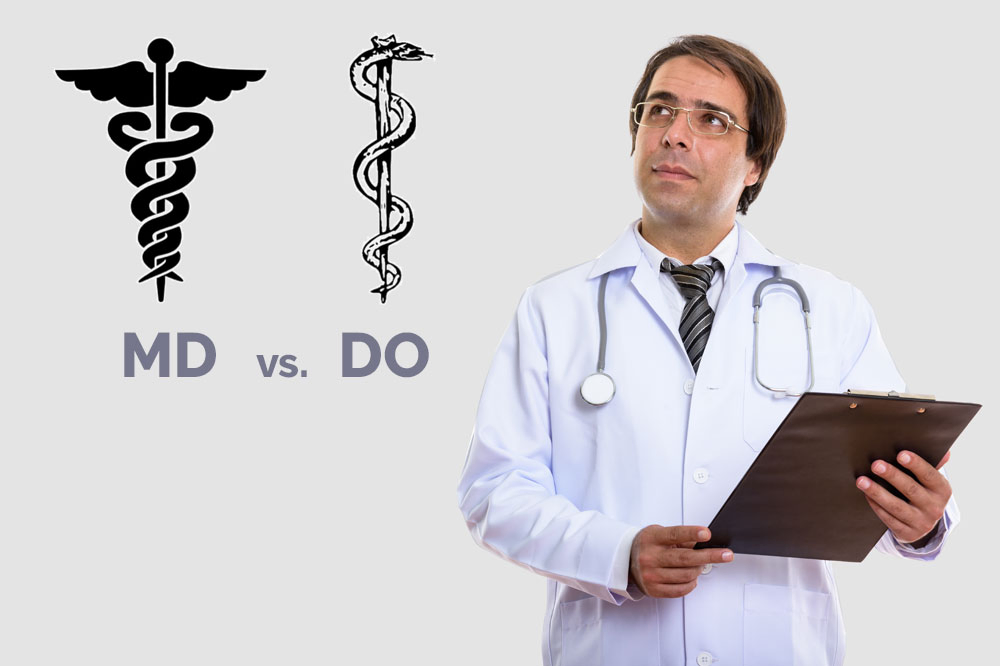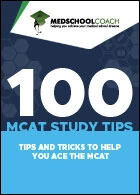
Table of Contents
When you apply to medical school, you may apply to both DO and MD schools. Or if you’re a patient deciding whether to see an MD or DO physician, rest assured they are both qualified doctors. Let’s talk about the differences.
DO vs. MD: A DO (Doctor of Osteopathic Medicine) and an MD (Doctor of Medicine) are both physicians who can practice medicine in the United States, but they approach treatment, education, and medical training slightly differently.
- MDs practice allopathic medicine (treating disease). MDs take USMLE board exams to be fully licensed.
- DOs tend to take a more holistic approach to healthcare (prevention of disease, emphasizing overall wellness). DOs take the COMLEX licensing exam rather than the USMLE.
Both degree programs put medical students on the path to practice medicine and provide patient care. In this article, let’s take a closer look at the similarities and differences between DO and MD degrees, so you can make an informed decision.
Worried about getting accepted? Boost your confidence levels with our free Medical School Chance Predictor, so you can make the wisest decisions and not waste your valuable time.
Differences to Know as a Patient
From a patient perspective, the main difference between an MD and a DO is their philosophical approach to patient care.
MDs practice allopathic medicine, the classical form of medicine focused on diagnosing and treating human diseases.
DOs follow a more holistic approach, viewing the body as an interconnected system and focusing on preventive care. They also receive additional training in osteopathic manipulative medicine (OMM), a hands-on treatment used to diagnose, treat, and prevent illness or injury.
Nowadays, DOs and MDs are becoming more interchangeable as DOs use more allopathic methods, and MDs focus more on holistic care.
MDs and DOs providers are both well-educated, trained healthcare professionals. They can both prescribe medication, diagnose and treat illnesses, and perform surgery in the United States. Patients can expect to receive quality treatment regardless if the physician has an MD or DO after their name.
Differences in Medical School Applications
Applying to medical school in the United States typically involves one of two primary application services:
- AMCAS (American Medical Colleges Application Service) for allopathic (MD) programs, administered by AAMC (Association of American Medical Colleges)
- AACOMAS (American Association of Colleges of Osteopathic Medicine Application Service) for osteopathic (DO) programs administered by AACOM
Please note: Medical students applying to schools in Texas may also need to use the Texas Medical & Dental Schools Application Services (TMDSAS), depending on the school.
Here are the primary differences between MD and DO applications:
- Course Classification: AMCAS is much stricter about what counts as a science course. AACOMAS will allow a wider range of courses to be classified as science courses, including astronomy and geology.
- GPA Classification: AMCAS and AACOMAS calculate the GPA slightly differently. AMCAS includes all attempted coursework in its GPA calculations, while AACOMAS only includes courses taken for credit.
- Fees: The fee for AMCAS is $175 (plus $45 for each additional school) and the fee for AACOMAS is $198 (plus $57 for each additional school). Both application services offer fee assistance programs.
- Application Timelines: AMCAS and AACOMAS operate on slightly different timelines. AMCAS usually opens in early May and can be submitted in late May or early June. AACOMAS, on the other hand, usually opens in early May and can be submitted immediately.
There are also similar requirements between AMCAS and AACOMAS:
- Both require a bachelor’s degree.
- Both require specific prerequisite coursework to be completed.
- Both ask for demographic information.
- Both have you write a personal statement.
- Both require letters of recommendation, although AACOMAS has a minimum of 2 while AMCAS requires 3.
- Both make you fill out a Work and Activities section.
- Both require you to take the Medical College Admission Test (MCAT).
However, the average GPA and MCAT scores of matriculants can vary between allopathic medical schools (MD programs) and osteopathic medical schools (DO programs). Typically, MD matriculants have higher average GPA and average MCAT than DO school matriculants.
| Average GPA | Average MCAT Score | |
| For MD Matriculants | 3.77 | 511.7 |
| For DO Matriculants | 3.55 | 503 |
SOURCE: AACOM’s Applicant and Matriculant Average MCAT 2016-2024, AAMC’s MCAT Scores and GPAs for Applicants and Matriculants to U.S. Medical Schools, 2020-2021 through 2024-2025
Osteopathic schools (DO-granting) tend to accept more non-traditional students whose admissions statistics may not be as strong but whose CVs include extensive life and/or pre-med experiences.
Read Next: Applying to Med School as a Non-Traditional Applicant
Use this quick guide to compare personal statement character lengths between both applications:
| Personal Statement Character Limit | Activities Section | Most Meaningful Activities | |
| MD (AMCAS) | 5,300 characters (including spaces) | 700 characters (including spaces) | Three activities can be selected as a “most meaningful activity.” You’ll have an additional 1,325 characters for these. |
| DO (AACOMAS) | 5,300 characters (including spaces) | 600 characters (including spaces) | Not applicable |
Training and Medical Education
Both allopathic and osteopathic medical students spend their first years of med school in the classroom and in the lab studying subjects like biochemistry, anatomy, and biomedical ethics.
They then spend the final two years in clinical rotations across various medical specialties such as pediatrics, family medicine, and internal medicine.
Nowadays, MDs and DOs have very similar training and medical education.
One main difference in the training DOs receive is the special focus on the musculoskeletal system. In DO programs, over 200 hours of instruction in osteopathic manipulative medicine (OMM) or osteopathic manipulative treatment (OMT) have to be completed. See more below.
Licensing Exams (USMLE vs. COMLEX)
To become medical doctors, students of both degree programs will be assessed on their medical knowledge, principles learned, and ability to provide effective patient care — but with two different licensing exams.
The licensure for MD and DO graduates differ.
- MD students take the United States Medical Licensing Examination (USMLE). This exam consists of 3 steps, with the first two steps taken during medical school and the third step taken after the first year of MD residency.
- DO graduates are required to take the Comprehensive Osteopathic Medical Licensing Examination (COMLEX). The COMLEX also consists of 3 steps (called “Levels”), which are taken at the same time as the USMLE Step exams. Each COMLEX Level exam also includes a section on OMM, reflecting the osteopathic emphasis on the musculoskeletal system and a whole-person approach to treatment.
Note: Some osteopathic medical students elect to take both the COMLEX and the USMLE exams as a way to enhance the competitiveness of their residency applications. However, only COMLEX is required to become a fully licensed DO physician.
Read Next: How to Effectively Study for USMLE Step 1
The Match and Residency
Residency is a 3- to 7-year-long postgraduate training program after earning a DO or MD degree. Residents have the opportunity to hone their skills in a particular specialty. MDs and DOs used to apply to different residencies, but now they compete for the same residency spots via NRMP.
Both MD and DO graduates apply for residency programs through the National Resident Matching Program (NRMP), often referred to as “The Match.”
Both DOs and MDs can practice in any specialty, but due to the holistic nature of osteopathic medicine, osteopathic doctors are more often seen in primary care specialties.
According to the AAMC’s most recent Physician Specialty Data Report, 36% of MDs practice in primary care fields (including family medicine, internal medicine, and pediatrics). The AOA reports 57% of DOs practice in primary care.
Background: In 2020, the AOA and the Accreditation Council for Graduate Medical Education (ACGME) completed a 5-year transition to a single accreditation system for all U.S. residency programs. Before this, DO graduates had the opportunity to match for residency spots via NMRP or the American Osteopathic Association (AOA) Match.
This merger allows DO graduates to compete for the same residency spots as MD graduates, having one residency match, and further aligning the training paths of MDs and DOs.
We can help you match with the residency of your choice with comprehensive coaching.
What Is OMM?
U.S. medical schools that grant DOs have similar curricula to traditional MD programs, plus an additional 200 hours of training in Osteopathic Manipulative Medicine (OMM).
What is OMM? OMM is when osteopathic physicians use their hands to diagnose and treat injuries and illnesses, using techniques such as joint mobilization, stretching, and massage. OMM is covered extensively on the COMLEX licensing exam.
OMM, also called Osteopathic Manipulative Treatment (OMT), is a hands-on technique for diagnosing and treating a range of musculoskeletal conditions, from minor headaches to severe back pain. It may be used in conjunction with or in place of medication.
Note: OMM/OMT may be similar to chiropractic adjustments in some ways, but they aren’t the same thing.
According to Dr. Tyson DeLengocky, DO:
“OMM incorporates aspects of traditional manual therapy, soft-tissue massage therapy, and other body-based modalities to relieve pain from strained muscles, tendons, and joints and improve motion and function of blood circulation, lymphatic and respiratory systems.”
This unique approach equips osteopathic physicians with a more whole-body understanding of how an injury or illness in one part of the body can affect the rest. However, not every DO actually uses OMM in their practice.
Pros and Cons: DO vs. MD
Below, I discuss the pros and cons of MD vs. DO, including a few very nuanced details:
| Pros | Cons | |
| MD |
|
|
| DO |
|
|
Whether you choose to become an MD or a DO, the path will always involve a dedication to serving patients’ healthcare needs. Both allopathic and osteopathic physicians share the common goal of promoting health and healing, albeit through slightly different approaches.
Ultimately, the choice between an MD and a DO depends on your personal philosophy, your career goals, and the type of doctor you aspire to become.
Our enrollment team can help you prepare your application for your ideal MD and DO med schools.
FAQs
Yes, a DO can become a surgeon, but it is less likely than an MD becoming a surgeon. In 2022, 4.6% of surgeons had a DO. However, that same year, 13.1% of surgery residencies were filled by DOs, so that low 4.6% is likely increasing every year.
The MD/PhD is another track to consider if you’re highly interested in research. Similar postgraduate degrees include dentistry (DDS), veterinary (VMD), or a Master’s degree in the mental health field.
There are also bachelor’s degrees that allow you to work in the medical field, such as nursing, health sciences, public health, and health administration.
If you’re pursuing an MD but you aren’t interested in patient care, check out this resource: Beyond Patient Care – Other Uses for an MD.
Making the choice between pursuing an MD vs. DO education is a personal decision. You must evaluate your life goals and interests to see which philosophy of medicine is the best path for you.
If you imagine yourself working at a prestigious hospital in a competitive specialty tackling rare medical cases, an MD could be the better choice.
If you’re looking to treat common illnesses, promote overall wellness, and become a figure of trust in your local community, a DO might be the right path for you.
The income of DOs versus MDs can vary drastically. DOs tend to enter general fields like family medicine and internal medicine, which are two of the lowest-paying specialties. MDs, on the other hand, often specialize in competitive fields like dermatology, cardiology, and surgery, which are some of the highest paying.
DOs, however, are just as capable of earning a salary on par with their MD counterparts. It’s not the degree that limits their earning potential — it’s the specialties they tend to opt into.
For example, a DO and MD who specialize in dermatology and practice in the same area would earn about the same amount.
Where to Find Help Applying to MD or DO Schools
We’ve given you a lot to think about when it comes to making a decision about medical degrees while applying to medical school. But we are offering you even more help. Check out our free Med School Explorer tool, or talk to us if you’re interested in one-on-one application consulting.
Schedule a free 15-minute consultation with us to learn how we can help boost your chances of success getting into medical school.

Sahil Mehta MD
Dr. Mehta is the founder of MedSchoolCoach and has guided thousands of successful medical school applicants. He is also a practicing physician in Boston where he specializes in vascular and interventional radiology.





